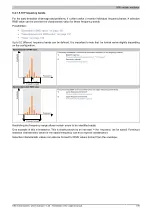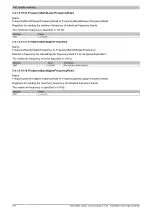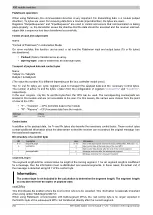
X90 mobile modules
X90 mobile system User's manual V 1.20 - Translation of the original manual
189
5.4.1.5.10 Frequency bands
For the early detection of damage and problems, it is often useful to monitor individual frequency bands. A selective
RMS value can be used as the characteristic value for these frequency bands.
Possibilities:
•
"Broadband RMS value" on page 191
•
"Speed-dependent RMS value" on page 191
•
"Noise" on page 192
Up to 32 different frequency bands can be defined. It is important to note that the format varies slightly depending
on the configuration.
Speed-dependent RMS value
Amplitude
Frequency
1)
- 2)
+ 2)
Frequency band
Frequency broadband is formed from the speed frequency ± the frequency interval.
1)
Speed frequency:
"FrequencyBandxxDmgFreq60Rpm"
*
"ActSpeed"
2)
Frequency interval:
"FrequencyBandTolerance"
Speed-independent RMS value
Amplitude
Frequency
1)
2)
Frequency band
Frequency bandwidth is formed of the lower and upper frequency band limits.
1)
Lower frequency band limit:
"FrequencyBandLowerFrequency"
2)
Upper frequency band limit:
"FrequencyBandUpperFrequency"
Restricting the frequency range allows certain errors to be identified easily.
One example of this is imbalance. This is clearly shown by an increase in the frequency line for speed. Forming a
selective characteristic value for the speed frequency can thus improve classification.
Selective characteristic values can also be formed for RMS values formed from the envelope.






























